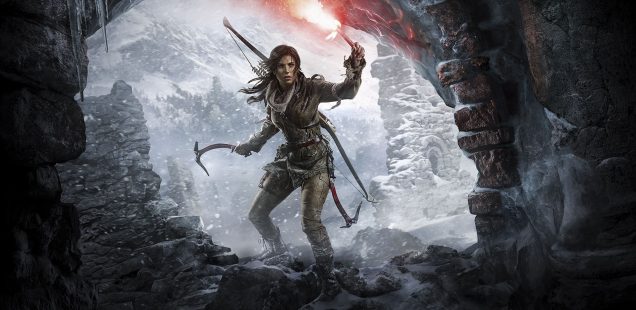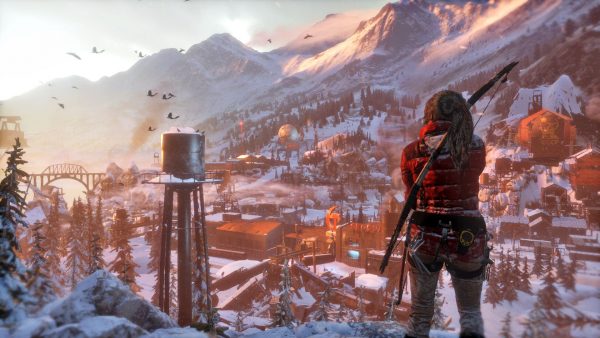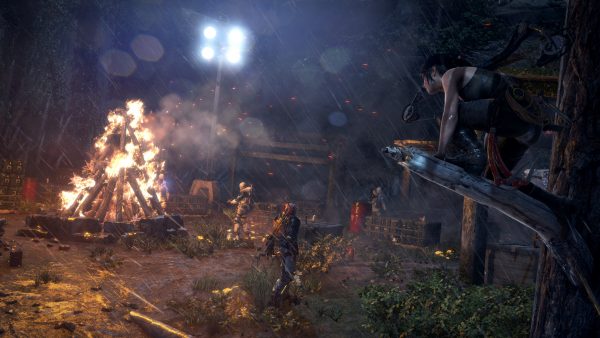
Due Diligence: Open Whaaa?
Leigh Harrison maps out the tomb.
I was a touch too young to play the original Tomb Raider games on the PlayStation, but I was always aware of them. Here in the UK at least, Lara Croft was a national icon, a woman who elicited so much pride she threatened to topple even the Queen as our favorite female media construct. Having missed the initial boat, my first true foray into globe-hopping archaeology was the 2013 reboot, which takes place on a single island and gives very little time over to, ya know, raiding tombs. While not the most accurate representation of the series at large then, it’s an undeniable romp, one that takes the basic action adventure components of the old games and modernizes them for my lazy millennial sensibilities.
Who am I kidding? The Tomb Raider reboot is great because it’s Uncharted but better. Furthermore its sequel, Rise of the Tomb Raider, is largely inferior because it’s a lot more like Uncharted than it should be.
As impressive as Nathan Drake’s wet t-shirt is, I’ve never really got along with the Uncharted school of adventuring. His adventures are linear foregone conclusions, and his unstoppable momentum robs his travails of any suspense, making them difficult to care about. The games essentially take place in long corridors with pretty and expensive scenery on the walls, but no number of lush or dangerous vistas hide the fact that Nathan Drake is always on an inescapable march forwards, and that eventually he will win and I’ll get to do something else.
Tomb Raider is sprawling by comparison. It has all the “running along stuff as it falls apart” and “climbing up stuff as it falls apart” you’d expect in the age of Nathan Drake, but these set pieces sit alongside and often within larger, less linear environments. This openness allows me to approach both combat and platforming with a rewarding degree of freedom. There’s only ever two of three courses of action in any given situation, but in offering anything other than a single critical path, Tomb Raider is simply more interesting.
Uncharted’s linearity is exhausting, and things happen in such quick succession that they all blur together. Climb this, engage these enemies, jump a chasm, climb some more, shoot other bad guys. Activities are laid out one after the other for Drake, which while creating an undeniably relentless pace, also funnels me from one thing to the next making me more tourist than participant. It’s hard to shake the feeling that levels sit entirely within a vacuum, as Drake enters stage right, does some stuff, and then exits the other side. What’s right in front of me is the only important thing, and once I’m done with it the set will change and I’ll move onto the next.

Tomb Raider creates levels right out of the Metroidvania playbook, its world existing as a series of open spaces, interconnected but essentially separate. The map even divides itself into chunks, showing how to move between areas but making it clear that each is self-contained. These locations are visited and revisited throughout the game, and as Lara learns new ways of traversing them – opening previously locked doors, climbing once insurmountable cliffs etc. – they subtly change and expand. Unlike Drake, Lara actually explores the places she visits, slowing the game down a touch, but adding thematic richness.
Both characters are purportedly archaeologists, though their gung-ho actions don’t do much to back this up. LUDONARRATIVE DISSONANCE ALERT: Nathan Drake and Lara Croft spend a lot of time killing dudes. Indeed, Lara might actually like it a whole lot more. What sets them apart, though, is that level design. Drake can’t do his job properly because there are no dark corners for him to explore, the best he’s got is to climb across yet another conveniently placed precipice. If he doesn’t, he’ll just stand there, because he has nowhere else to go, forever. Or at least until we exhaust our fossil fuel supply, realize we should’ve invested more in renewables, and the power goes out. When this does happen, we’ll finally put the question of whether archaeologists are capable of killing hundreds of people to bed, because the answer will be yes: they’ll stab you in the eye for a bottle of water in the post-apocalypse. And they’ll kill your entire family for good measure.
Tomb Raider doesn’t have to wrestle with such problems, because Lara is open about killing simply to survive, and the game’s levels are large and nonlinear enough to offer the scope for some proper archaeology. They’re full of treasure-filled nooks, and while hunting them out is but a distraction in the grand scheme, it goes a long way to anchoring Lara within a world she seeks to explore, understand, and ultimately surmount. She’s first and foremost an adventurer doing lots of adventuring, there’s just a load of bad men intent on making that difficult for her. Tomb Raider offers a good balance of thrills ‘n’ spills and player agency, building an adventure that’s as much about exploration as it is cinematic action set pieces.
Rise of the Tomb Raider is very different, and most of this stems from its level design. It’s meant to be a bigger, more confident doubling-down of everything the first does so well, but I can’t help but being deeply frustrated by it. The same ingredients are all in there, but the game is fundamentally flawed in its world building. Its spaces are at once grander but also more Uncharted-like; large areas filled with smaller, linear sections of dead ends and points of no return. They kill its pace and rubbish the first’s sense of openness and freedom.
Where Tomb Raider does offer linear sections, they are removed from the larger areas and exist as “one and done” episodes filled with platforming and dexterity challenges. Lara might climb a mountain, get into a fight, and then descend in some dramatic and explosive way. The mountain locale contains this set piece and nothing else, and becomes inaccessible once the game is finished with it. Rise curiously doesn’t do this, and in some cases actively sends me back to these deliberately single-use places in the pursuit of its newly-implemented side missions.

Early on in the game I’m tasked with infiltrating an old gulag. To get in, Lara climbs a radio tower and ziplines from it like the action hero she so obviously is. As she reaches the bottom, the game switches to cutscene and she is captured. The ensuing level is a thrilling mix of stealth and combat, as I escape custody and then pick my way between buildings under the cover of darkness. It’s a constrained area, offering only a single path that weaves its way across the hill in the most convoluted way possible. This doesn’t matter though, because Lara’s aim is simply to get in and out with as little fuss as possible, and the level’s linearity creates a claustrophobia that propels me onwards and builds tension. There’s only one way to go, so getting spotted holds real weight, as it’ll make my flight that much more difficult. Here, linearity works well, because it complements what the game’s asking me to do.
About an hour later I’m sent back to the gulag as part of a side mission to hunt for valuable information. I immediately return to the zipline tower, hoping to retrace my steps in the most efficient way possible. But the zipline isn’t there. Because the game immediately hits a cutscene the first time around, that bit of the camp doesn’t actually exist as a playable section of the level, so the zipline is just removed from the world to prevent me finding this out. I instead have to fast-travel into the center of the camp and go from there.
To allow me to progress, certain parts of the level are altered. Ladders are erected to let me climb back up falls I’ve taken, and a tunnel has opened up to bypass another place that only exists in a cutscene. I retrace my steps from the previous visit, seeing doors I’d locked behind me and corners I’d hidden in, but this time everything is eerily quiet. I’m in a videogame level I’ve already completed, a place that feels like I shouldn’t even be able to visit again, save for the design concessions that have mysteriously popped up allowing me to do so. But more than this, the level hasn’t changed that much. There are fences that could be removed to refigure the whole space, to blow it open and remove the linearity. It really wouldn’t be hard. As it stands, a couple of additions allow me to move backwards and forwards through the original layout, but I’m treading a path already well worn, which makes the artificiality of the space – and in turn me being there again at all – strikingly obvious.
Rise‘s most fundamental error of judgement is in conflating open ended with open world. While its levels offer the scope for multiple approaches and routes, that doesn’t mean they can harbor all the trappings of an open world game. Rise goes to town with its side missions and collectibles in a much bigger way than Tomb Raider, throwing hidden documents, ancient coins, murals, chests, maps, challenges, and resource caches everywhere like it was Assassin’s Creed. They can all be ignored I suppose, but they’ve been but there to be sought, and in many cases tie directly into Lara’s character and weapon upgrades, so I do so at my peril.

As a result of this, Rise forces the me to look right at the artificiality of its spaces time and time again. I know, for example, that when I pass a point of no return going into a combat encounter it’s for my own good; to provide me with a controlled arena within which to engage my enemies and play the scenario as it was intended. That’s fine, it get it. But at the same time there’s a weapon upgrade I missed just before it, and if I want to grab it, which I of course do, I’ll need to come back this way again. I’ll fast travel into an earlier, now largely empty location, run over the same log bridge, that will threaten to fall into the same chasm, in exactly the same way it did the first time. And if I happen to miss a document or other such collectible? I’ll do it a third time, and the log won’t fall then either.
Tomb Raider struck a perfect balance between offering the scripted and controlled thrills of Uncharted and a more rewarding exploration-driven scale. Rise expands upon everything, but in doing so loses sight of what was so remarkable about the first game’s spaces. Sheer scale is not important when our understanding of locations changes with our capacity to move within them. Tomb Raider’s dead ends were only ever temporary – eventually, every cliff that mattered could be climbed and every important door opened. No part of a level was arbitrarily locked or rearranged to suit a momentary whim. If I couldn’t get there it was for good reason, and I’d be granted access when the time was right.
Rise builds bigger spaces, but is much more controlling of how I use them. It’s impasses are permanent, used to funnel me and dictate my movements. In and of itself this wouldn’t be a problem, but the game asks me to return to these barriers time and time again, beating me over the head with how they are simple mechanical contrivances.
The game creates spaces for one purpose and then expects them to work for another one entirely. It willingly pulls back the curtain and shows off the whirring cogs and pulleys of its design. Its levels work well when all the scripted explosions are pushing me in the right direction, but many devolve into convoluted messes when revisited, making it clear they’re not really made to be experienced a second time. I find Tomb Raider is more rewarding than Uncharted because it lets Lara run in directions other than straight forwards. Rise of the Tomb Raider isn’t sure where it wants me to go at all, and instead of adventure and exploration it’s filled with confusion and monotony at every turn – whichever direction that might be in.
Leigh Harrison lives in London, works in communications for a medical charity, and owns a hamster. He likes canals and rivers a great deal, and spends a lot of his time walking. He occasionally says things about videogames on the Internet, and other things on The Twitter.